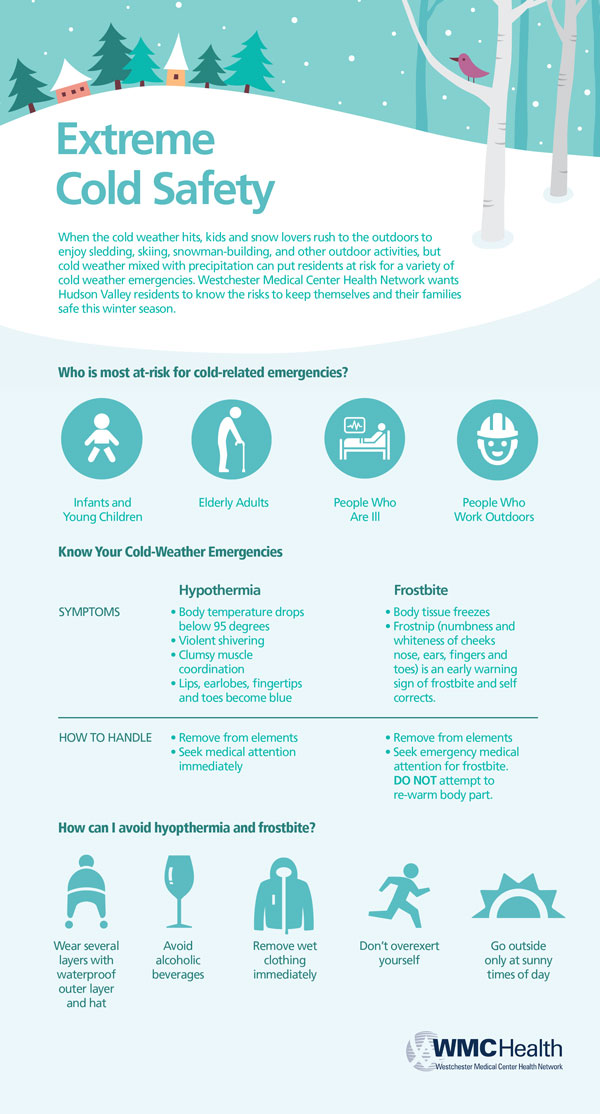Temperatures are expected to drop to the frigid single digits this week, bringing with them serious health concerns such as hypothermia and frostbite, especially in young children, older adults, and those who work outdoors.
Westchester Medical Center Health Network reminds Hudson Valley residents to take the necessary precautions and offers cold-weather tips to help keep families safe during the forecasted plunge in temperatures.
"The key to staying safe during our colder winter days and nights is staying warm and dry," said Ivan Miller, MD, Medical Director of the Emergency Department at Westchester Medical Center, Maria Fareri Children's Hospital and MidHudson Regional Hospital, adding that once people begin to feel cold or notice that their clothes are wet, it is a sign that their body is having a difficult time replenishing heat and frostbite and hypothermia become a concern.
The Centers for Disease Control and Prevention offers these cold weather safety tips, endorsed by Dr. Miller, to prevent cold weather emergencies:
- Wear several light layers with a waterproof outer layer and a hat. The head is a source of heat loss for our bodies. Ears, fingertips and noses are also extremely susceptible to frost nip and frost bite.
- Avoid consuming alcoholic beverages, as alcohol does not warm the body. In fact, it has an opposite effect by causing vasodilatation and decreasing the body's natural insulating properties. It also suppresses shivering, and impairs judgment.
- If you must be outside, limit your exposure to the cold by limiting your exposure to times when the sun is at its strongest.
- Know your limitations. Don't over exert yourself and don't be afraid to ask for help.
- Check on the elderly.
Dr. Miller advises that anyone who suspects symptoms of hypothermia or frostbite should remove themselves from the elements and seek medical attention immediately.

Stages of Hypothermia
When body temperatures drop below normal (around 98.6 degrees), the body reacts by shivering, a series of small muscle contractions that use energy (calories) to create heat. "Goose bumps" form, raising body hair on end in an attempt to create a layer of insulation around the body. Usually this returns the body temperature to normal. Shivering is the body's normal reaction to minor heat loss.
If the loss of body heat continues and body temperatures drop below 95°, shivering will become more violent, muscle coordination will become clumsy as movement and speech begin to slow, even though the person may appear alert. Lips, earlobes, fingertips and toes may become blue as vessels contract to bring warmth to vital internal organs.
Left untreated, hypothermia becomes severe and could possibly result in death when body temperature drops below 86°. Victims may experience lethargy, unconsciousness, seizures and even cardiac arrest.
Frostnip and Frostbite
Frostbite is frozen body tissue – It usually involves just the skin, however, sometimes it goes deeper - and must be handled very carefully in order to prevent permanent tissue damage or loss. Children are at greater risk for frostbite than adults, both because they lose heat from their skin more rapidly than adults (they have a higher body surface area compared to their overall size) and because they may be reluctant to leave their winter fun to go inside and warm up.
People can prevent frostbite in cold weather by dressing in layers, staying aware of surroundings and going indoors at regular intervals as well as watching for frostnip, frostbite's early warning signal. Frostbite is a true emergency and must be treated in an emergency department.
Frostnip usually affects areas that are exposed to the cold, such as the cheeks, nose, ears, fingers, and toes, leaving them white and numb. Frostnip corrects itself when the area is re-warmed, however left untreated, frostnip can quickly lead to frostbite.
(click infographic to download)